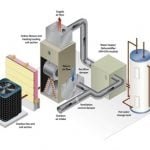Why Is My Furnace Blowing Cold Air
If you’re wondering, “Why is my furnace blowing cold air?” this comprehensive guide provides insights into common issues and solutions. From ignition failures and thermostat troubles to circuit control board malfunctions and gas supply problems, each section addresses specific causes. Explore safety mode activation, cracked heat exchanger risks, and the impact of blocked vents. Learn the importance of furnace maintenance and discover troubleshooting steps to ensure your heating system operates efficiently. Reclaim your comfort with informed measures against winter discomfort.
How Does A Furnace Work?
Understanding the HVAC system’s heating cycle is crucial for troubleshooting your furnace. When the indoor temperature drops, the thermostat signals the control board to initiate heating. The combustion process, activated by the ignition switch, warms the heat exchanger. Blower fans then circulate the heated air through your home’s ducts. Knowing this process helps in identifying why your furnace might be blowing cold air.
Common Causes of Furnace Blowing Cold Air
1. Ignition Failure: No Fire
Your furnace may not blow hot air due to ignition failure. Without ignited burners, your home won’t heat up. Explore reasons disrupting the ignition process and ensure a consistent heat source.
2. Thermostat Troubles
A malfunctioning thermostat can lead to cold air blowing out when the heat is on. Understand how the thermostat communicates with the furnace and troubleshoot issues affecting the heating cycle.
3. Circuit Control Board Malfunction
The circuit control board, acting as the furnace’s brain, may malfunction, leading to the blower working without the burners. Learn the importance of maintenance to prevent circuit board issues.
4. Pilot Light or Electric Ignition Problems
Issues with the pilot light or electric ignition can result in cold air. Explore the differences between the two and discover solutions to keep your furnace running efficiently.
5. Gas Supply Problems
If your gas furnace fails to ignite, it could be a gas supply issue. Understand the role of the gas valve and the importance of timely refills for uninterrupted heating.
6. Safety Mode Activation
Learn about safety mode and how an overheating furnace triggers it. Understand the impact on heating consistency and ways to address the issue.
7. Cracked Heat Exchanger
A cracked heat exchanger poses risks of carbon monoxide poisoning. Explore the symptoms, risks, and preventive measures to ensure a safe heating system.
8. Blocked Vents and Airflow Issues
Obstructions in vents and airflow issues affect heating efficiency. Discover the impact of blocked vents and practical solutions for optimized furnace performance.
9. Importance of Furnace Maintenance
Emphasize the significance of regular furnace maintenance. Learn about the benefits and preventive measures to avoid cold air surprises. Invest in the longevity of your heating system.
Troubleshooting Steps
Step 1: Check Thermostat Setting
Ensure the thermostat is set to Heating Mode and the fan is set to AUTO. Closed vents or blocked registers can sabotage the heating process.
Step 2: Evaluate and Adjust Your Vents
Open vents allow proper airflow. Check and ensure all vents are open and unblocked for efficient heating.
Step 3: Assess Furnace Filters
Dirty filters disrupt air circulation. Regularly change or clean filters to maintain heating system efficiency.
Step 4: Call An HVAC Pro
When troubleshooting fails, seek advice from a certified HVAC technician. Safety is paramount when dealing with gas and electricity.
How To Prevent Furnace Blowing Cold Air
Regular furnace maintenance is the key to preventing heating issues. An annual checkup by a certified HVAC technician ensures optimal performance. Components like the thermostat, heat exchanger, main limit switch, and filters are inspected, tightened, and cleaned, preventing potential problems.
Reclaim Your Comfort
Understanding the reasons behind a furnace blowing cold air empowers you to take proactive measures. Whether it’s ignition failure, thermostat issues, or blocked vents, informed troubleshooting and preventive maintenance are your allies against winter discomfort.





